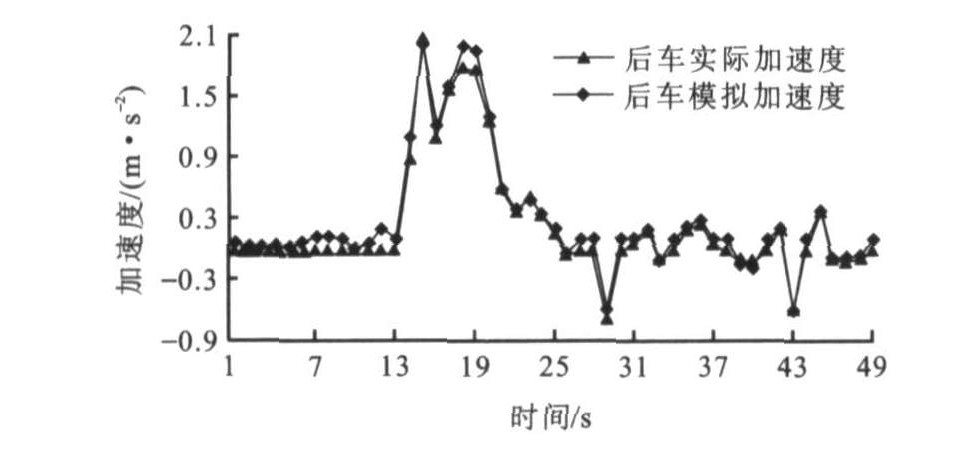Nonparametric microscopic simulation model of driving behavior
Article Text (Baidu Translation)
-
摘要: 运用信息挖掘技术最大限度地榨取实测数据所携带的驾驶行为个体有用信息, 通过数据修正和精简形成样本数据库, 采用K最近邻概率密度函数法对样本数据库进行数据过滤和冗余信息清洗, 利用预处理后的数据和非参数回归法构建了驾驶行为非参数仿真模型。模拟得到的后车多元信息与其实际值有很好的拟合性, 且实际值以模拟平均值为轴小幅度摆动。仿真结果表明, 合适的光滑参数能提高模型精度, 使模型避免大样本标定数据的限制, 很好地反映和预测跟驰过程中的驾驶员行为。Abstract: Information mining technology was used to extract useful individual driving information from field measure data, driving sample database was established by amending and condensing field measure data, field measure data and redundant information were filtered by K nearest probability density function estimation method, a new simulation model of driving behavior was established based on nonparametric regression method. It is pointed that the real multi-resource information values of following vehicle are same as the simulated average values, and the field data swing around the simulated ones. Simulation result shows that appropriate smoothing parameter can improve the model accuracy, avoid the calibration limitation of giant sample data, and driving behavior can be reflected and forecasted in car-following process.
-
表 1 部分数据
Table 1. Part of data

-
[1] 王晓原, 隽志才, 贾洪飞. 开发和评价ITS的微观交通流仿真模型[J]. 交通运输工程学报, 2002, 2(1): 64-66. http://transport.chd.edu.cn/article/id/200201014Wang Xiao-yuan, Juan Zhi-cai, Jia Hong-fei. Micro-simulation models of traffic flowof developing and evaluating ITS[J]. Journal of Traffic and Transportation Engineering, 2002, 2(1): 64-66. (in Chinese) http://transport.chd.edu.cn/article/id/200201014 [2] 杨宏志, 许金良. 基于Multi-Agent的公路仿真系统框架[J]. 长安大学学报: 自然科学版, 2005, 25(1): 25-28. doi: 10.3321/j.issn:1671-8879.2005.01.006Yang Hong-zhi, Xu Jin-liang. Framework of highway simulation systembased on multi-agent[J]. Journal of Chang an University: Natural Science Edition, 2005, 25(1): 25-28. (in Chinese) doi: 10.3321/j.issn:1671-8879.2005.01.006 [3] 陈斌, 金炜东, 高利. 特殊过程下的车辆跟驰模型数值模拟分析[J]. 中国公路学报, 2005, 18(1): 90-94. doi: 10.3321/j.issn:1001-7372.2005.01.018Chen Bin, Jin Wei-dong, Gao Li. Numerical simulation and analysis of car-following models on particular progress[J]. China Journal of Highway and Transport, 2005, 18(1): 90-94. (in Chinese) doi: 10.3321/j.issn:1001-7372.2005.01.018 [4] 王晓原, 隽志才, 贾洪飞, 等. 基于安全间距的车辆跟驰模型研究综述[J]. 长安大学学报: 自然科学版, 2004, 24(6): 51-54. doi: 10.3321/j.issn:1671-8879.2004.06.013Wang Xiao-yuan, Juan Zhi-cai, Jia Hong-fei, et al. Summarization of car-following models based on security distance[J]. Journal of Chang an University: Natural Science Edition, 2004, 24(6): 51-54. (in Chinese) doi: 10.3321/j.issn:1671-8879.2004.06.013 [5] Mark B, Mike M. Car-following: a historical review[J]. Transportation Research: Part F, 1999, 2(4): 181-196. doi: 10.1016/S1369-8478(00)00005-X [6] 王晓原. 微观交通流仿真建模理论及一体化仿真环境研究[D]. 吉林: 吉林大学, 2002. [7] 王晓原, 宿宝臣, 孟昭为. 微观交通仿真跟驰模型影响因子选择研究[J]. 软科学, 2004, 18(2): 16-19. https://www.cnki.com.cn/Article/CJFDTOTAL-XUXI200402004.htmWang Xiao-yuan, Su Bao-chen, Meng Zhao-wei. Factor analysis to choose the input variable of car-following model for microscopic traffic simulation[J]. Soft Science, 2004, 18(2): 16-19. (in Chinese) https://www.cnki.com.cn/Article/CJFDTOTAL-XUXI200402004.htm [8] Silverman B W. Density Estimation for Statistics and Data Analysis[M]. New York: Chapman Hall, 1986. [9] 王晋国, 王卫亚, 田丰, 等. 智能导航车载系统[J]. 交通运输工程学报, 2005, 5(2): 106-109. http://transport.chd.edu.cn/article/id/200502025Wang Jin-guo, Wang Wei-ya, Tian Feng, et al. Vehicle device systemof intelligent guiding[J]. Journal of Traffic and Transportation Engineering, 2005, 5(2): 106-109. (in Chinese) http://transport.chd.edu.cn/article/id/200502025 [10] Scott D W. Multivariate Density Estimation Theory, Practice and Visualization[M]. New York: A Wiley-Interscience Publication, 1992. -





 下载:
下载:






